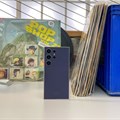As South Africa grapples with economic challenges, introducing luxury devices for affluent markets, like the Samsung Galaxy Z Fold6, seems tone-deaf. While the global market for foldables may be expanding, with Samsung projecting 100 million foldable phones to be sold by 2028, it’s becoming increasingly clear that these premium devices have limited appeal in a country like ours. Despite the technology's allure, foldables are ill-suited to South African realities, even for the wealthy.

The Samsung Z Fold6 is the best foldable smartphone the Korean giant has ever produced, but the party trick is getting stale.
When I spoke to Justin Hume, VP of mobile at Samsung South Africa, at the Galaxy Z Fold6 launch event, he was quick to highlights the global popularity of foldables.
“We certainly are seeing sustained, each iteration, an increased demand coming forward.”
Globally, the foldables market is expected to reach substantial numbers by 2028, but the situation in South Africa is markedly different.
With the cost of living rising sharply and smartphone penetration still not universal, the introduction of premium devices and exclusive features, which can exceed R40,000, feels disconnected from the needs of most South Africans.
It seems like the collective motive of the smartphone industry is to grow profits and market share by inventing expensive fads that encourage upgrade cycles, instead of making the core smartphone experience demonstrably better.
Networks not making it better
Vodacom CEO Shameel Joosub recently emphasised the urgency of closing the digital divide.
Only 35% of people in low-income countries have access to 4G, and in South Africa, this divide is still significant.
Joosub called for "bold, transformative action" to ensure universal access to digital services, expressing the need for affordable connectivity, not premium gadgets.
Vodacom’s response? A R250 feature phone that can’t connect to the country’s most widely used communications platform (WhatsApp) but relies on cloud connectivity via data connection.
Predatory contracts and the true cost of "affordability"
A key concern with the introduction of high-end devices like the Galaxy Z Fold6 is the rise of predatory 48-month smartphone contracts.
These extended financing terms are marketed as a solution to affordability, but they create long-term financial burdens. I was offered Vodacom’s 48-month payment plan on my recent device upgrade to “lower the monthly payments” according to the salesperson.
Doing the quick maths, the approximately R150 monthly saving over the 36-month option I carried over from my previous contract – I organically stumbled into a three-year device cycle at the beginning of the decade – was nullified by a 20% increase of the device cost over the lifetime of the four-year lock in.I couldn’t recover that on a trade even if I sold it on the private market.
Unsustainable
These contracts are not a sustainable solution for making premium phones “affordable” but rather an exploitation of consumer desire for cutting-edge technology.
Customers who opt for these contracts often face high cancellation fees and long term costs that far exceed the phone's initial retail price.
With inflation and economic uncertainties, locking oneself into a four-year contract is financially risky. It’s clear that these strategies, while marketed as inclusive, may exacerbate the very affordability crisis they claim to address.
But I digress.
Damage costs
With Galaxy Z Fold6, Samsung has made significant strides in improving the durability of its foldable devices.
"The hinges are far more durable...shock and impact absorption properties are significantly improved," said Hume.
Yet, for the average South African consumer, who is already stretched thin financially, any concerns about durability add to the reasons to be cautious, especially when Samsung South Africa device insurance benefits when it launched its new foldables.
Currently (promotional period ends 31 October) Samsung Care+ Standard for Galaxy Z Fold6 (or Z Flip6) comes with additional R1,000 once off cost for a single screen replacement in a 12-month period.
Should you require a screen replacement in that first year of ownership, you’ll be asked to spend a further R1,500 “repair fee”.
A repair fee/access fee of R1,499 (one thousand four hundred and ninety-nine rand) will be applicable on a screen repair in the twelve (12) month offer period.
Previous experience with Fold and Flip owners tells me that screen replacements are needed.
Compromised hardware
The true dealbreaker for me that makes the Galaxy Z Fold6 unsuitable even for its target audience is that foldables also lag behind in areas like camera quality, an important consideration for South Africans who may only upgrade their devices every few years.
For the price of a foldable, you could instead buy an excellent Galaxy S24 Ultra, which is a higher quality flagship phone with superior performance across the board, without the risks posed by foldables’ still-evolving technology.
Choosing the Ultra Galaxy even gets you the S-pen – which makes more sense for the Z Fold6 functions – included in the price.
The Z Fold6 is still a weird device with non-standard screen aspect ratios that many of the most used Android apps – looking at you, Instagram – still don’t respond well to, and is quite bad for watching videos or playing games.
And it’s plagued by being too thick, heavy and fragile to reasonably carry in a pants pocket on a family walk out in nature.
Market rejection
Foldables may be positioned as the next big thing in global tech, but in a country where basic smartphone access is still a luxury for many, the Samsung Galaxy Z Fold6 is an indulgence few can justify.
By all indications, Z Fold6 is also 10% down in sales compared to the previous iteration and there seems to be a slowdown in fold sales outside of China.
Samsung is also facing intense competition from other Android phone makers in the folding market that they created, but I suspect the order books for Samsung components are strong enough to balance out those losses.




































